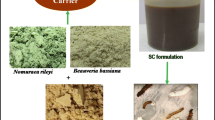Abstract
Bacillus thuringiensis (Bt) spray products are devoid of protection against undesirable environmental conditions (UV light, heat, dew, phylloplane materials), and are partially effective against bollworm larvae. To improve this situation, we embedded the spore-crystal product in a granular feeding bait formulation. The granules were made of wheat meal used as both a carrier and a feeding stimulant; yeast extract also was incorporated into the granules, to stimulate larval feeding. A combination ofBt subsp.kurstaki andaizawai products was used in the granular formulation, to widen the host-range of the microbe against lepidopteran insects. The most effective size of granules, as studied in a controlled experiment in a dispersion tower, ranged between 149 and 210μ. The granular product dusted on cotton was more active than theBt spray (Dipel) againstEarias insulana. The present paper evaluates otherBt adjuvants and formulations.
Similar content being viewed by others
References
Bartelt, R.J., McGuire, M.R. and Black, D.A. (1990) Feeding stimulants for the European corn borer (Lepidoptera: Pyralidae): Additives to a starch-based formulation forBacillus thuringiensis.Environ. Entomol. 19:182–189.
Bell, M.R. and Romine, C.L. (1980) Tobacco budworm field evaluation of microbial control in cotton usingBacillus thuringiensis and a nuclear polyhedrosis virus with a feeding adjuvant.J. Econ. Entomol. 73:427–430.
Ben-Yehuda, S., Wysoki, M. and Rosen, D. (1992) Laboratory evaluation of microbial pesticides against the honeydew moth.Hassadeh 72:585–589 (Hebrew, with English summary).
De Barjac, H. and Frachon, E. (1990) Classification ofBacillus thuringiensis strains.Entomophaga 35:233–240.
Dunkle, R.L. and Shasha, B.S. (1988) Starch-encapsulatedBacillus thuringiensis: A new method for increasing environmental stability of entomopathogens.Environ. Entomol. 17:120- 126.
Knowles, B. (1994) Mechanism of action ofBacillus thuringiensis insecticidal β-endotoxin.Adv. Insect Physiol. 24:275–307.
Luttrell, R.G., Young, S.Y., Yearian, W.C. and Horton, D.L. (1982) Evaluation ofBacillus thuringiensis—spray adjuvant—viral insecticide combinations againstHeliothis spp. (Lepidoptera: Noctuidae).Environ. Entomol. 11:783–787.
McGuire, M.R., Shasha, B.S., Lewis, L.C. and Nelson, T.C. (1994) Residual activity of granular starch-encapsulatedBacillus thuringiensis.J. Econ. Entomol. 87:631–637.
Meisner, J. and Ascher, K.R.S. (1968) A method to assay the phagostimulatory effect towards insects of plant extracts applied to Styropor®disks.Riv. Parassitol. 29:74–79.
Navon, A. (1993) Control of lepidopteran pests withBacillus thuringiensis.in: Entwistle, P.E., Cory, J.S., Bailey, M.J. and Higgs, S. [Eds.]Bacillus thuringiensis, An Environmental Biopesticide: Theory and Practice. J. Wiley & Sons, New York, NY. pp. 125–146.
Navon, A., Federici, B.A., Walsh, T.S. and Peiper, U.M. (1992) Mandibular adduction force ofHeliothis virescens (Lepidoptera: Noctuidae) larvae fed the insecticidal crystal ofBacillus thuringiensis.J. Econ. Entomol. 85:2138–2143.
Navon, A. and Grinstein, A. (1995) Development of granularBacillus thuringiensis larval- feeding bait formulation.Phytoparasitica 23:80 (abstr.).
Navon, A., Ishaaya, I., Baum, D., Ben-Ari, Z., Braun, S., Yablonski, S. and Keren, S. (1994) Activity ofBacillus thuringiensis preparations for control of the vinemothLobesia botrana. Laboratory and field experiments 1991–1993.Alon haNotea 48:360–366 (Hebrew, with English summary).
Navon, A., Klein, M. and Braun, S. (1990)Bacillus thuringiensis potency bioassays againstHeliothis armigera, Earias insulana, andSpodoptera littoralis larvae based on standardized diets.J. Invertebr. Pathol. 55:387–393.
Navon, A., Keren, S., Levski, S., Sachs, Y., Nakache, Y. and Lazar, M. (1996) Granular Bacillus thuringiensis—feeding bait formulations for the control of moth pests. 2nd En-Gedi Conf. on Bacterial Insect Pests and Vectors of Human Diseases (Shoresh, Israel), abstr. no. 39.
Navon, A., Meisner, J. and Ascher, K.R.S. (1987) Feeding stimulant mixtures forSpodoptera littoralis (Lepidoptera: Noctuidae).J. Econ. Entomol. 80:990–993.
Richter, A.R. and Fuxa, J.R. (1984) Preferences of five species of Noctuidae for feeding stimulant adjuvants.J. Ga. Entomol. Soc. 19:383–387.
Spies, A.G. and Spence, K.D. (1985) Effect of sublethalBacillus thuringiensis crystal endotoxin treatment on the larval midgut of a moth,Manduca: SEM study.Tissue & Cell 17:379–394.
Author information
Authors and Affiliations
Corresponding author
Rights and permissions
About this article
Cite this article
Navon, A., Keren, S., Levski, S. et al. Granular feeding baits based onbacillus thuringiensis products for the control of lepidopterous pests. Phytoparasitica 25 (Suppl 1), S101–S110 (1997). https://doi.org/10.1007/BF02980337
Issue Date:
DOI: https://doi.org/10.1007/BF02980337




